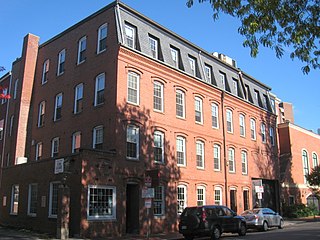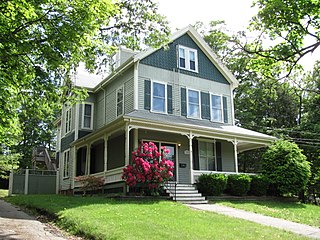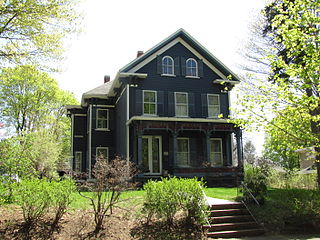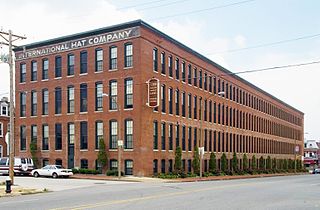
Buford is a city in Gwinnett and Hall counties in the U.S. state of Georgia. As of the 2020 census, the city had a population of 17,144. Most of the city is in Gwinnett County, which is part of the Atlanta-Sandy Springs-Marietta Metropolitan Statistical Area. The northern sliver of the city is in Hall County, which comprises the Gainesville, Georgia Metropolitan Statistical Area and is part of the larger Atlanta-Athens-Clarke-Sandy Springs Combined Statistical Area.

A. H. Stephens State Park is a 1,177 acres (476 ha) Georgia state park located in Crawfordville. The park is named for Alexander H. Stephens, the Vice President of the Confederate States of America, and a former Georgia governor. The park contains Stephens' home, Liberty Hall, which has been fully restored to its original 1875 style. The park's museum houses one of Georgia's largest collections of American Civil War artifacts. The park also offers several mill ponds for fishing and nature trails.

The Reversible Collar Company Building is a historic factory building at 25–27 Mt. Auburn & 10–14 Arrow Streets in Cambridge, Massachusetts. The building has a complex construction history, consisting of several buildings constructed separately between 1862 and 1907, and gradually combined into a single structure. The oldest portions were built by Allen and Farnham, a printing business. The property was sold to the Reversible Collar Company in 1867, which expanded the facility. The company at first manufactured paper shirt collars, but later also produced paper and paper-fabric combinations for use in products like wall charts and maps. The buildings on the site were sold to the Boston Bookbinding Company in 1897. In the late-1960s the building was converted to office and commercial space.

The Hamilton-Brown Shoe Factory was the first large scale industrial operation in Columbia, Missouri. It was built in 1906-1907 by the Brown Shoe Company, the largest shoe manufacture in the world at the time. It was the first plant built outside of St. Louis and was operational from 1907-1939 The building today has been converted into offices.

The Pratt House is a historic house in Reading, Massachusetts. The two-story wood-frame house built in 1809 and is stylistically a transitional Georgian/Federal structure. The main portion of the house is a single room deep, and there is a two-story shed-roof extension on the rear. The house belonged to various members of the locally prominent Pratt family, including Joseph Pratt, the first Reading shoe manufacturer to use a stitching machine.

The Smith Shoe Shop is a historic ten-footer shoe workshop at 273 Haverhill Street in Reading, Massachusetts. The small outbuilding is one of a few surviving remnants of the local cottage industry of shoemaking that flourished in the 19th century. These were called "ten footers" because of their relatively small size, and fell out of favor after the introduction of factory-based methods for shoe production in the decades following the American Civil War.

The Bernard Cogan House is a historic house at 10 Flint Avenue in Stoneham, Massachusetts, United States. Built about 1885, it is a good local example of Queen Anne style architecture in the United States. It was built for Bernard Cogan, the son of a local shoe factory owner. The house was listed on the National Register of Historic Places in 1984.

The House at 15 Lawrence Street in Wakefield, Massachusetts is a well-preserved Queen Anne house with a locally rare surviving carriage house. It was built in the early 1870s, and was listed on the National Register of Historic Places in 1989.

The House at 20 Lawrence Street in Wakefield, Massachusetts is a complex residential structure with elements of Queen Anne, Stick style, and Colonial Revival style. Built about 1880, it was listed on the National Register of Historic Places in 1989.

The House at 23 Lawrence Street in Wakefield, Massachusetts is a good example of a late 19th-century high-style Colonial Revival house. Built in the late 1890s, it was listed on the National Register of Historic Places in 1989.

15 Wave Avenue is a well-preserved Italianate style house in Wakefield, Massachusetts. It was built between 1875 and 1883, and was listed on the National Register of Historic Places on July 6, 1989.

The Bona Allen Company is a tannery and leather goods factory that opened in 1873 in Buford, Georgia. It became the nation's largest producer of hand-tooled saddles, bridles, horse collars, postal bags, cowboy boots, and shoes and had a contract to supply the sporting equipment giant, Spalding, with raw material for the manufacture of baseballs and baseball mitts. Starting in the early 20th century Bona Allen saddles were offered in the Sears Mail Order catalog under a variety of names. The Bona Allen Company was owned by Bonaparte Allen Sr. Also known as the Bona Allen Shoe and Horse Collar Factory, the factory closed in 1981 after a fire, and the main tannery building was added to the National Register of Historic Places on January 3, 2005. It is located at 554 West Main Street. After another fire on February 10, 2015, firefighters allowed the building to burn itself down.

The John Quincy Allen House is a historic residence in Buford, Georgia. Its architectural style is described as Georgian Revival architecture. It was added to the National Register of Historic Places in 1984. It is located at 345 East Main Street.

The Hoyt Shoe Factory is a historic factory complex at 470 Silver Street and 170 Lincoln Street in Manchester, New Hampshire. It consists of two once-identical four-story brick factory buildings which face each other across Silver Street. Built in the 1890s, they housed the city's largest shoe manufacturer, an industry that gained in significance as its textile industry declined. The complex was listed on the National Register of Historic Places in 1985.

The Kimball Brothers Shoe Factory is a historic factory building at 335 Cypress Street in Manchester, New Hampshire. The four-story brick building was built in stages between 1885 and 1900, and was a prototypical structure from which the design of other period shoe factories in Manchester were built. Construction was overseen by Head & Dowst, a builder responsible for a number of area public buildings, including schools and prisons. It was funded by local businessmen seeking to diversify the local economy, and was leased to the Kimball Brothers, a leading shoe manufacturer in Lynn, Massachusetts. The building was listed on the National Register of Historic Places in 1985.

The Queensbury Mill is a historic mill building at 1 Market Street in Somersworth, New Hampshire. Built in 1884, it is unusual for the period for its wood-frame construction, and for its financing, executed by local businessmen to attract shoe manufacturers to the city. The mill was listed on the National Register of Historic Places in 1987. The building has been converted into apartments.

Brown Shoe Company's Homes-Take Factory, also known as the International Hat Company Warehouse, is a historic building location at 1201 Russell Boulevard in the Soulard neighborhood of St. Louis, Missouri. Built in 1904, by renowned architect Albert B. Groves, the building was originally a factory for the Brown Shoe Company, based in St. Louis. In 1954, the factory was subsequently converted into a warehouse by the International Hat Company. The site has been recognized as a testament to Grove's architectural expertise in the principles of factory design, namely technical advances in layout planning, operational efficiency, and employee safety. Additionally, the factory epitomizes the early 20th century cultural transformation and socio-industrial development of St. Louis into a manufacturing powerhouse. In particular, the Brown Shoe Company is recognized as a principal player in challenging the 19th century dominance of the New England shoe industry. This significantly contributed to the early 20th century sobriquet of St. Louis as the city of "shoes, booze, and blues." The Brown Shoe Company's Homes-Take factory is considered to be among the pioneering industrial facilities of this historic transformation.
John F. Downing was an American architect based in Atlanta, Georgia.

The Bona Allen Mansion, also known as Bona Allen House, at 395 Main St. in Buford, Georgia, in Gwinnett County. It was listed on the National Register of Historic Places in 1983. It was built in 1911. It was it home of Bona Allen, Sr.

Haralson Bleckley was an American architect who designed many buildings in his hometown of Atlanta, Georgia. Several of his works are listed on the National Register of Historic Places (NRHP). His office was in the Flatiron Building. He also proposed the Bleckley Plaza Plan, a largescale architectural project that would have seen the creation of a large plaza in downtown Atlanta.




















